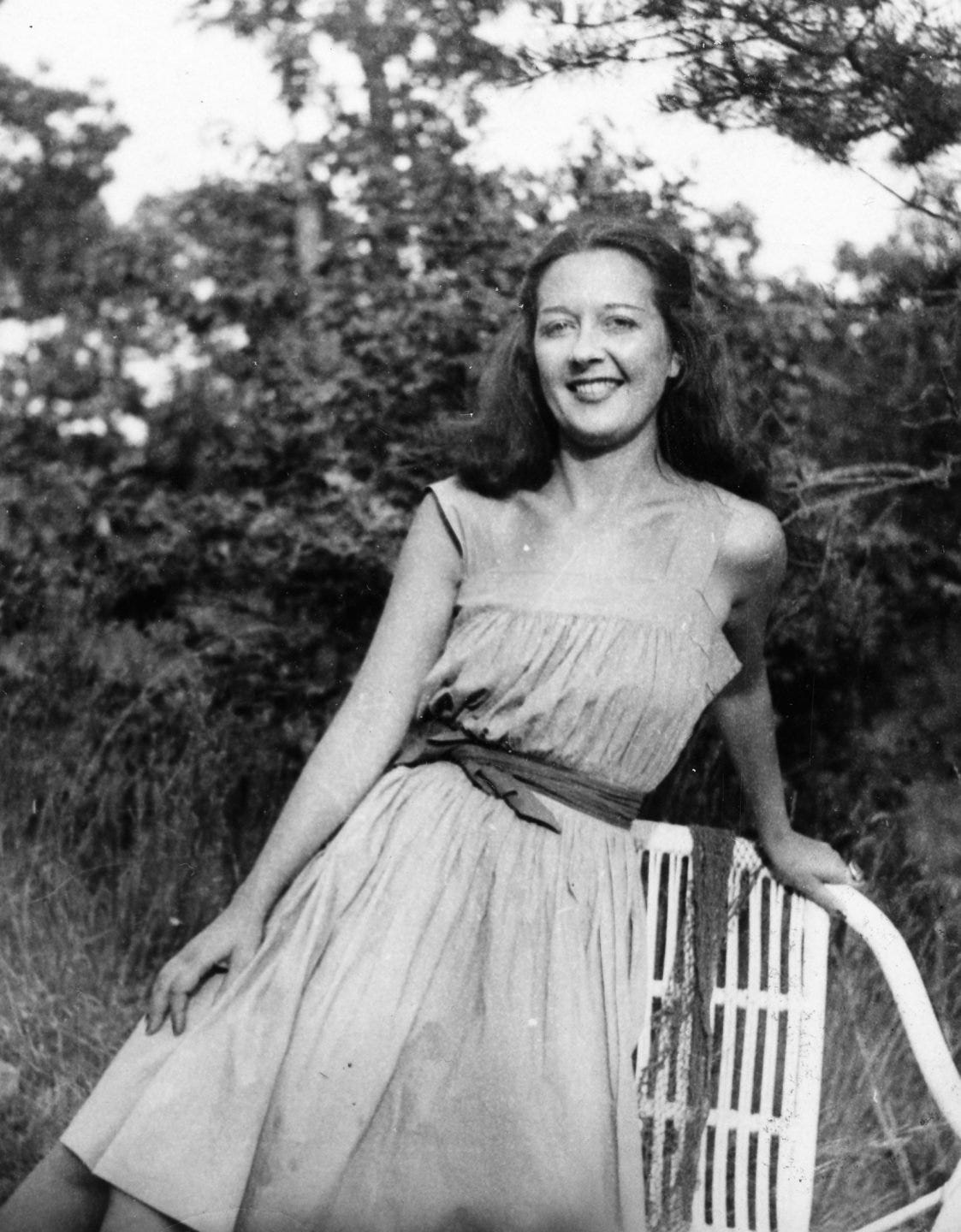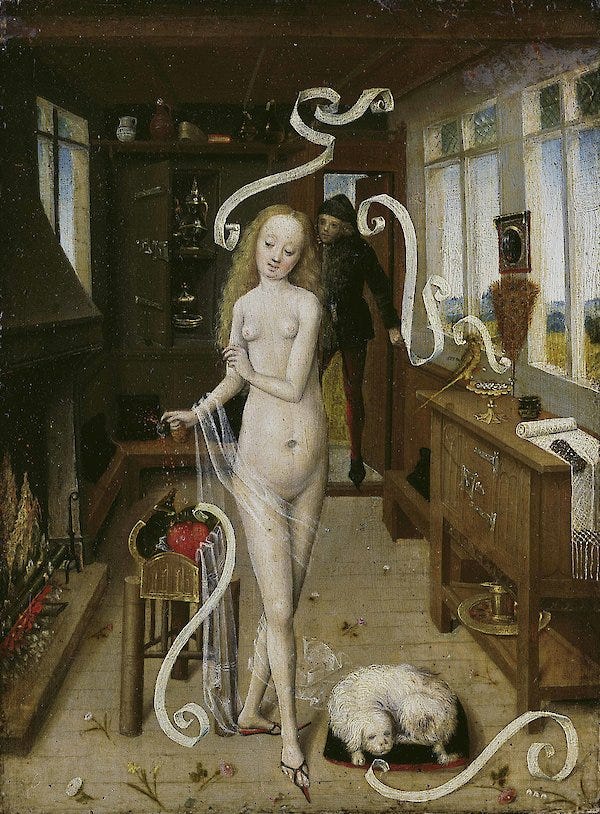The show had come down heavy over New York in the winter of 1942. Max Ernst had fled Europe, where the war raged on. Leaving a trail of damp footsteps behind him, he climbed up the steps to the apartment door. Little could prepare him for what he found behind it. His visit was motivated by his search for paintings to feature in an exhibition called Thirty Women, organised by Peggy Guggenheim.
He was welcomed in by a pretty face, of which he had seen many. The young woman led him through rooms with no rugs and scarce furnishings. As they entered her studio, the apartment’s back room, they approached a painting. She averted her gaze. He could not. On the easel stood a portrait of a young woman, whose hand rests on the handle of a door, which exposes a hallway of doors beyond doors.
‘What do you call it?’, he asked.
‘I really haven’t a title’, she replied.
‘Then you can call it Birthday.’ 1
Dear coven,
For this week’s enchantment, I chose Dorothea Tanning’s striking portrait, Birthday. Enchantment of the week is a weekly series in which I talk about works of art motivated by magic. These usually follow an introduction of the artist from the previous week. You can read the introduction to Dorothea Tanning’s work here.
Dorothea Tanning’s Birthday was her initiation to Surrealism. The bare-breasted, barefoot figure in her painting looks disheveled. Roots hang from her skirt, tangled and grasping for surface. At her feet, a winged, lemur-like animal lingers. The presence of this creature suggests Tanning’s knowledge of transformation, of a transitional moment in her life, denoted by the dreamscape of countless doors. 2 The dishevelment should not be taken as a weakness, it should be seen as evidence of a journey. The figure possess access to unknown realms, it is her hand that opens the door, it is at her feet that the creature lies.
Tanning’s oeuvre was motivated by the occult, Gothic literature, alchemy and witchcraft. The latter we see in Birthday’s iconography, in particular with the winged animal in the corner of the canvas. The enchantress is nothing without her subservient pet creature. This one in particular has been identified as a famulus. According to Medieval and Renaissance demonology, the famulus drinks the milk of a witch, Tanning’s figure has perhaps claimed this role. 3
Female artists associated with Surrealism incorporated the occult in their work in a different manner to their male peers. Magic functioned as a means of empowerment and a reversal of stereotypical gender roles. Within male Surrealism magic was gendered - the male magus and poet seers, and the female sorceress, with a power to tap into the irrational. This left women in a supplementary position, they were seen as a crucial part to the creative process, important, yes, but always, a part.
Much of Tanning’s interest in alchemy has been attributed to her marriage to Max Ernst, a similar assumption was drawn about Leonora Carrington due to her own relationship with Ernst. But make no mistake, the notion that these artists needed the men in their lives to get an introduction to magic is simply untrue, Tanning, like Carrington, had a long-standing interest in magic:
I've always been drawn towards esoteric phenomena: the illogical, the inexpressible, the impossible. Anything that is ordinary and frequent is uninteresting to me, so I have to go in a solitary and risky direction. If it strikes you as being enigmatic, well, I suppose that's what I wanted it to do. 4
Furthermore, when asked about her relationship with Ernst, Tanning was clear in highlighting his importance to her as a companion, rather than an artistic influence:
I was a loner, am a loner, good Lord, it's the only way I can imagine working. And then when I hooked up with Max Ernst, he was clearly the only person I needed and, I assure you, we never, never talked art. Never. We had a lot of fun and talked about all kinds of things, and showed each other new work, rather formally, with serious, but brief, comments. But we didn't talk about craft. 5
In Tanning’s Birthday, the woman is the bearer of knowledge, she is the whole. She reclaims the erotically charged Renaissance imagery of witches to unleash her creative power.
I hope you enjoyed reading about Dorothea Tanning’s Birthday.
If you are someone who is interested in learning more about painting and literature through the prism of magic and folklore, please consider subscribing to this newsletter and following its visual companion.
Thank you for reading!
Tip Jar ☕
Recent articles:
bibliography
Mahon, Alyce. ‘Of Kings and Queens: Alchemical Desire and the Imagination’. In Surrealism and Magic: Enchanted Modernity, edited by Gražina Subelytė and Daniel Zamani, 59–70. Munich: Prestel, 2022.
Tanning, Dorothea. Between Lives: An Artist and Her World. Evanston: Northwestern University Press, 2003.
Tanning, Dorothea, and Carlo McCormick. ‘Dorothea Tanning’. BOMB, no. 33 (1990): 36–41.
Dorothea Tanning, Between Lives: An Artist and Her World (Evanston: Northwestern University Press, 2003), 62-63.
Alyce Mahon, ‘Of Kings and Queens: Alchemical Desire and the Imagination’, in Surrealism and Magic: Enchanted Modernity, ed. Gražina Subelytė and Daniel Zamani (Munich: Prestel, 2022), 67.
Mahon, Of Kings and Queens, 67.
Dorothea Tanning and Carlo McCormick, ‘Dorothea Tanning’, BOMB, no. 33 (1990), 37.
Tanning and McCormic, Dorothea Tanning, 40.











